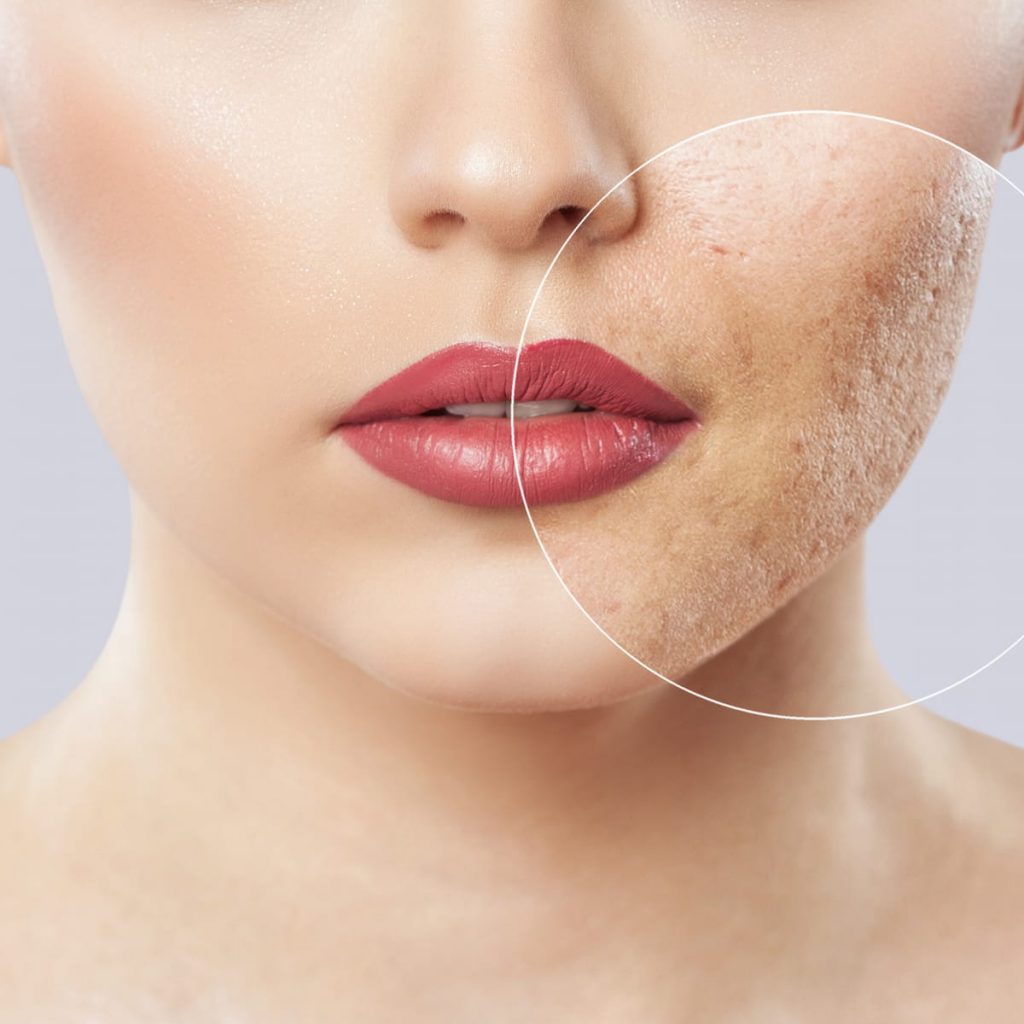Scar Treatment
If you have a scar you dislike or feel uncomfortable, we offer scar treatments individualized to your goals and scars.

What is Scar Revision?
A scar is a permanent change to your skin in response to an injury. When your normal skin and soft tissues (skin, fat, and muscle) are injured, they heal with scars.
Scar revision uses techniques and treatment modalities to improve scars’ appearance, texture, and function.
Many patients seek to improve the cosmetic appearance of scars. Others seek to improve symptoms such as pain or a decrease in function due to the scar. With our expert care, your scar’s appearance and symptoms can be improved.
We offer comprehensive treatments for scars caused by acne, surgery, or injuries. Treatment is individualized to your scar and treatment goals.
What Types of Scars Can You Treat?
We perform comprehensive acne scar combination treatments which minimize your downtime and maximize your results. Our combination treatments include subcision to release tethered scars, TCA CROSS (chemical reconstruction of skin scars) for ice-pick scars, and microneedling and resurfacing for boxcar and rolling acne scars. Together these combination treatments can significantly reduce or even sometimes erase the appearance of your acne scars.
- Acne Scars – Acne scars are formed from cystic acne. You should make sure your acne has been treated or is resolved before undergoing acne scar treatment. Once your acne has been controlled, you can pursue treatment for your acne scars.
- Raised Scars / Hypertrophic scars / Keloidal scars – Raised scars, also known as hypertrophic scars or keloidal scars, are very common. Hypertrophic scars are raised in the area of trauma. Keloidal scars produce excessive scar tissue such that the scar is larger than the initial injury. For example, after an ear piercing, a large keloid forms on the backside of your ear.
- Depressed Scars / Atrophic Scars – These scars lack collagen and elastic tissue, contributing to their depressed or atrophic appearance. This type of scar treatment focuses on increasing the collagen and elastic tissue and replacing lost tissue.
- Traumatic Scars / Injury Scars – Traumatic scars caused by car accidents, dog bites, burns, or other accidents can be very upsetting. We will listen to you to understand what you want to achieve with scar revision. Dr. Beal will then discuss different treatment options which are individualized to achieve your goals best.
- Discolored or Darkened Scars – Injury to the skin can produce darker or lighter scars than your normal skin. Sometimes we can replace the lost melanocytes for lighter scars, and for darker scars, we can use treatments to lighten the scars.
What Are the Best Scar Treatments?
We offer comprehensive scar treatments individualized to your goals and scars.
- Steroid Injections: For thickened, painful, or itchy scars, steroids can be injected to reduce these symptoms and improve the scar’s appearance. It is important to note these steroids are used locally in the scar, which reduces side effects. Side effects are typically limited to color changes and skin thinning.
- 5-Fluorouracil Injections: This medication can be injected to treat thickened, painful, or itchy scars. This medication does not have the side effect of skin thinning which or skin lightening. It works best when combined with steroid injections. Dr. Beal is one of the few dermatologists and facial plastic surgeons who use this medication to treat scars. Side effects of this medication include temporary skin darkening. If you intend to become pregnant or are pregnant, this is NOT an appropriate treatment for you. You should tell your doctor if you are pregnant or intend to become pregnant.
- Surgical Revision: Scars from trauma, such as car accidents, dog bites, and burns, can sometimes benefit from surgical removal of the old scar and reconstruction with meticulous surgical technique. By excising the old scar and re-suturing with meticulous surgical technique, the appearance and function of the scar can be improved.
- Resurfacing: This technique improves the texture and appearance of scars. Controlled injury is used to increase collagen and elastic tissue.
- Microneedling: Microneedling is a great modality for increasing collagen and elastic tissue. Dr. Beal uses physician-grade microneedling to improve the appearance of atrophic scars, such as acne scars.
- Fat Grafting: Fat Grafting can be used to help improve the texture and appearance of scars, including using it as a permanent filler. Fat cells are a store of stem cells that can be further used for scar rehabilitation. Fat grafting is a versatile and great way to improve the appearance of scars.
- Fillers: For atrophic scars that have lost volume, fillers can help replace the volume. The fillers used can be permanent or semi-permanent and are chosen based upon a comprehensive scar assessment and your treatment goals.
- TCA CROSS (Chemical Reconstruction of Skin Scars): TCA (trichloroacetic acid) treats depressed or pitted scarring. It involves the use of a concentrated chemical peel which helps to elevate the depressed scars.
- Subcision: Bound down or tethered scars benefit from subcision. This is a technique where the fibrous bands tethering the scar are released to restore a smooth facial appearance.
Combination Scar Treatments
Many patients have scars that would benefit from multiple treatment modalities. Using our experience and expertise, we combine multiple treatments to minimize your downtime and maximize your results. We tailor the specific techniques and modalities to achieve your goals.
GET IN TOUCH
